Archive for March 2008
Japan journey, part 2
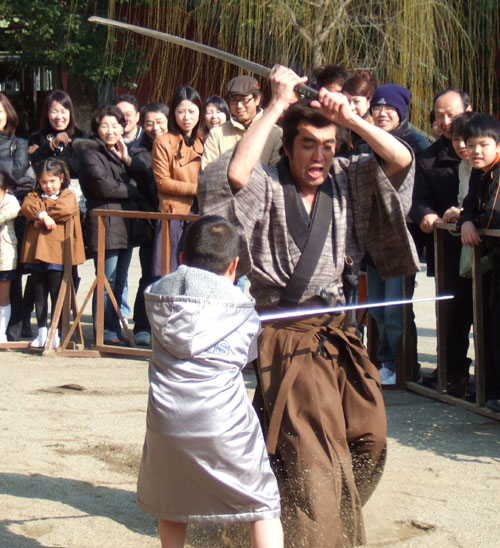
DB here:
A seesaw trip in my last few days in Japan, with notes on watching some rare movies, visiting some superheroes, and watching some children cut down swaggering samurai.
Kansai wanderer
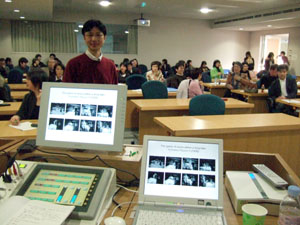
On Friday I traveled to Nagoya University with Yamanouchi Etsuko. She was my translator for a talk on Japanese film for my student, now professor, Fujiki Hideaki (above). Hideaki oversaw the translation of Film Art into Japanese and is the author of a new book on the growth of movie culture in Japan during the first decades of the century.
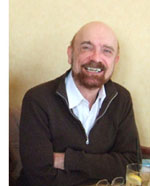 The talk seemed to go well, though my customary rapid-fire yammer sometimes left the fluent Etsuko breathless. Hideaki’s students and colleagues kept me on my toes with sharp questions. Then we all went out to a sumptuous dinner, where I had a chance to talk to many Nagoyans, including senior Japan expert Peter High, author of The Imperial Screen. Peter is now about to retire, as you can perhaps tell from his expression.
The talk seemed to go well, though my customary rapid-fire yammer sometimes left the fluent Etsuko breathless. Hideaki’s students and colleagues kept me on my toes with sharp questions. Then we all went out to a sumptuous dinner, where I had a chance to talk to many Nagoyans, including senior Japan expert Peter High, author of The Imperial Screen. Peter is now about to retire, as you can perhaps tell from his expression.
Because I lectured on what I call the “game of vision” in Japanese films, we had fun at dinner with composing shots that mimicked the peekaboo framings. Even relaxing, film wonks never turn off the movies running in our heads.
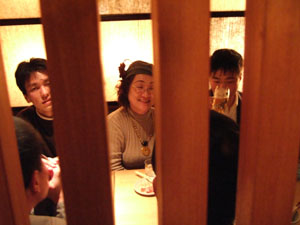
Next day I took a fairly impulsive trip to Kyoto. I tried to visit Mizoguchi’s grave, but had no luck finding it. After visiting it ten years ago, I shouldn’t have trusted my memory. Instead, I found Toei’s movie theme park, which provided me three hours of diversion.
Shochiku studios failed with its own theme park (go here for my reminiscence of it), partly because it had only Ozu and Tora-san as main attractions. But Toei has a bevy of swordplay heroes and….Power Rangers. An entire wing of the facility is dedicated to superheroes, life-size and some much larger.

I had no idea who these hardfaced bipeds were, but they sure looked pretty, with their nice snowmobiles and vaguely obscene gestures.
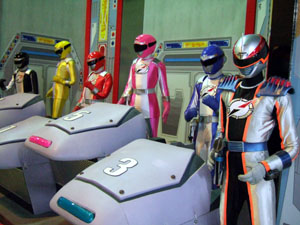

Elsewhere in the Toei park are streets evoking old Edo and Kyoto, as well as a kabuki theatre.

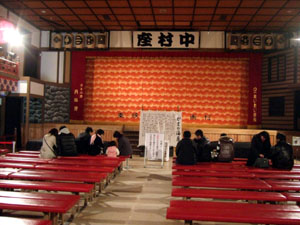
Mechanical ninja crawl around overhead, and samurai stroll the alleyways. You can watch a director pretending to shoot a TV show of swordplay in a studio set.
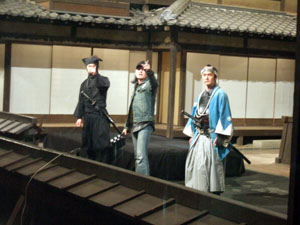
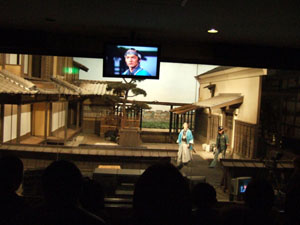
The most enjoyable moments came with a display of swordfight stunts carried out by three good-humored young samurai. They summoned from the audience a tiny boy, a somewhat older boy, and a tall little girl, and they gave them some elementary fighting skills. These skills consisted of stomping forward, crouching, and swinging the sword while letting out a blood-freezing shriek. The teachers made it look easy.
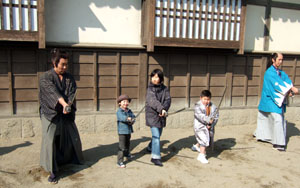
Then each kid was planted in front of the crowd and a swordsman rushed forward, with howling abandon. Miraculously, the kids’ fairly minimal defense tactics always defeated the men, who died in agony.
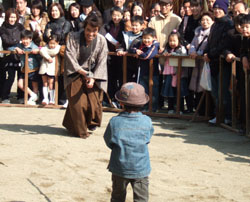
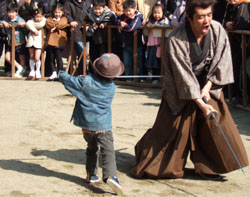
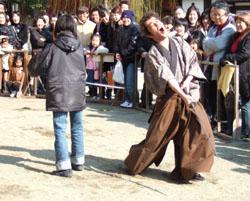
When one winner got obeisance from his enemies, he acted like the constantly scratching Mifune in Seven Samurai.
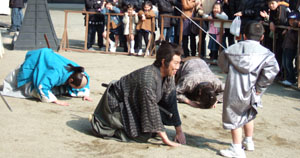
A new old Mizoguchi
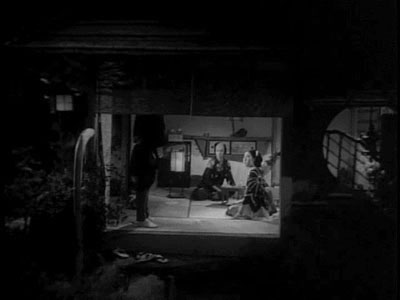
Back to Tokyo and a round of shopping, eating, and moviegoing. I was staying with Komatsu Hiroshi, a friend of almost thirty years whom I first met at a conference on Dreyer in Verona. Hiroshi is a monumental figure in silent-cinema circles, and I’m planning a later blog entry profiling him.
With Hiroshi I saw two silent Makino Masahiro films at the national Film Center. For more on this series, see an earlier entry. Chronicle of 3 Generations (Gakkusei san daki, 1930) consisted of two installments of a short-comedy series produced by Makino. In the first, a modern girl throws over her boyfriend because he’s a bad baseball player. The second was reminiscent of Ozu’s Days of Youth in showing a college student trying to hide his slacker ways from his visiting father.
The second film, also part of a series, was directed by Makino. Street of Ronin (Roningai, 1929) was a bustling tale of a neighborhood of ne’er do wells. The benshi commentator must have been busy; there are over 260 intertitles in a film of about 72 minutes. I can’t tell you what happened in the plot, but the movie shows yet again that by the end of the 1920s Hollywood continuity style was in full vigor here. Makino uses a remarkable number of different setups in each scene.
At Hiroshi’s house he screened many rare items from his collection, mostly silent European, American, and Japanese films. One of the most striking Japanese titles was Magic in the Dark (Kurayami no Tejina, 1927), an experimental short with some of the stylization one finds in Kinugasa Teisuke’s Page of Madness (1926). The rain-drenched night scenes are like something out of Murnau.
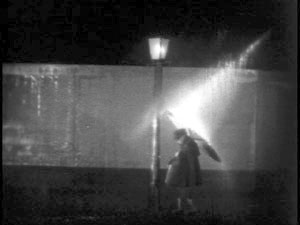
The plot is didactic and uplifting, showing how a boy tempted by money pursues a righteous path. Magic in the Dark was directed by Suzuki Shigeoshi, whose most famous film is What Made Her Do It? (1930). That famous but currently incomplete feature, along with Magic in the Dark, will be released on the Kinokinuya DVD series that Hiroshi directs. Alas, no English subtitles. (See the PS below.)
The killer item was a newly discovered Mizoguchi film, one that doesn’t appear on official filmographies! Miss Okichi (Ojo Okichi, 1935) was residing in the Shochiku vaults, and a copy, in beautiful condition, was recently screened on Japanese television. Mizo codirected it with Takashima Tatsunosuke, a director whose work I don’t know, for Dai Ichi Eiga, the production company he formed with Nagata Masaichi. Dai Ichi Eiga, which later became Daiei, financed Mizo’s masterpieces Naniwa Elegy (1936) and Sisters of Gion (1936).
A bit like The Downfall of Osen (Orizuru Osen, 1935), this film centers on a woman who’s a cat’s paw for a gang involved in shady dealings. Okichi, played by Yamada Isuzu (whose bosom I nestle against in my earlier entry), is pulling scams for the sake of her lover. But she falls out with the gang and takes pity on one of the young men whom she victimizes.
I can’t comment on the film after only one viewing, and the fact that Mizoguchi is credited after Takashima suggests that he may have had little input. Still, it’s another tale of a woman who sacrifices herself for more or less unworthy men. Miss Okichi also has some typically Mizoguchian scenes that dwell on chiaroscuro melancholy. Much of the film takes place at night, and this strategy reinforces the somber atmosphere. There are some remarkably opaque long shots and one moment that includes Okichi turning toward the camera in a sort of plaintive challenge.
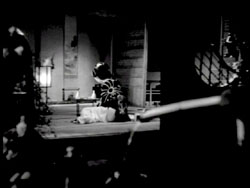
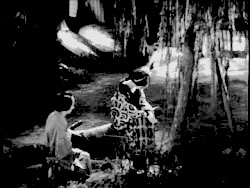
Given my admiration for Mizo, this capped a terrific ten days in Japan. Now on to Hong Kong, where I’ll blog at intervals on what happens at the Hong Kong Filmart market, the Asian Film Awards on Monday night, and the HK International Film Festival. I’ll be there, like Bernstein in Citizen Kane, before the beginning and after the end.
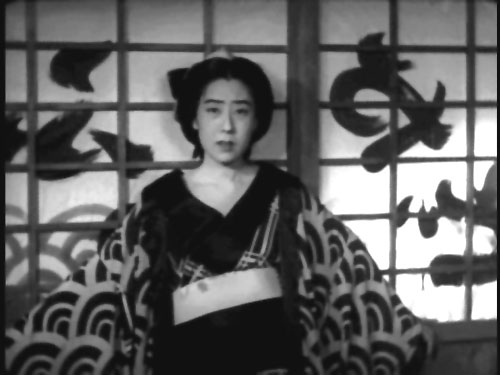
PS 24 July 2008: The Kinokuniya DVD of What Made Her Do It? has come out, and Joanne Bernardi reports that at least one version does have English subtitles…by her! Magic in the Dark is included on that disc. And despite information to the contrary, the DVD Joanne has is not Region 2 but all-region. Oddly, online listings of the DVD make no mention of these facts. Joanne does not yet know whether the subtitled all-region disc is the same as the one offered on amazon.jp and the Kinokuniya site, but it seems likely. More information as I get it, from Joanne or others.
Tokyo choruses
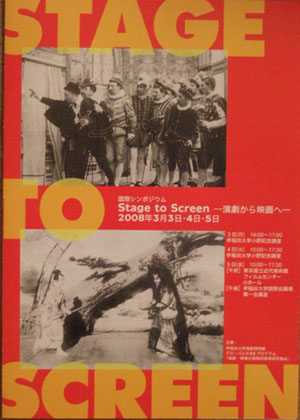
DB here:
I’ve had a terrific time since I arrived late last Saturday. The only thing that could have improved it would be the discovery that there was a Japanese town named Bordwell. If it could happen to Barack, why not me?
Actually, I know why not. On Sunday, a trip to a temple yielded a promise that nothing good would come on any front.
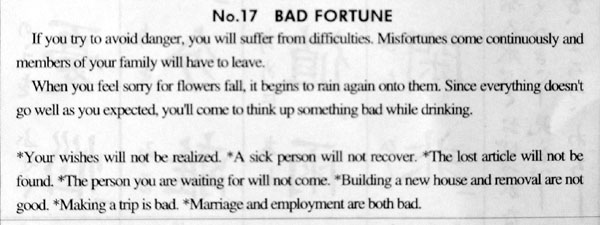
Pretty dire. Yet I press on, foolishly trusting that meals will be tasty, the city will shake me up, and three fine sorts of things will grace the first phase of my stay: the symposium, the movies, and my companions. Still, I vow to avoid thinking up something bad while drinking.
The conference
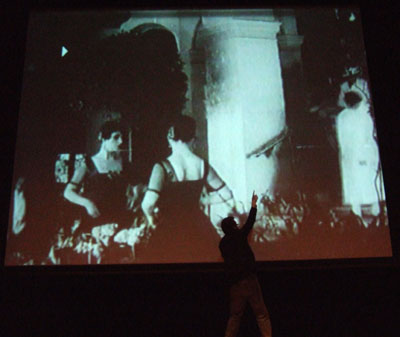
I came for a symposium at Waseda University, Stage to Screen. For three days local scholars delivered papers and comments about how cinema related to theatre.
Young researchers have done thorough work on the relation of Japanese cinema to the culture’s lively theatrical traditions. Usai Michika explored a topic that’s always fascinating–the benshi, the person who accompanied silent film with commentary and dialogue. She found a remarkable poster from the Waseda Theatre Museum collection illustrating many short films, and through diligent archive work she was able to identify most of the films. Although the poster came from 1899, the films were all pre-1896. Ogawa Sawako gave a thorough examination of how films were influenced by kodan, a sort of novelistic oral recitation. It turns out that kodan stories were at least as important as kabuki plays as sources of Japanese film, well into the 1920s. Shimura Miyoko studied later forms of rensa-geki, the mix of live performance and film that was fairly common in the silent era. She showed that there was a resurgence of it in the early 1930s, with sound cinema.
Western cinema attracted attention as well. Kataoka Noburo analyzed the relationship between Samuel Beckett’s Play and his Film, directed by Alan Schneider and starring Buster Keaton. Our host Professor Komatsu Hiroshi gave a talk called “Actors without Bodies,” suggesting the quasi-supernatural qualities of early film. He surveyed cinema’s links to the phantasmagoria shows of the French magician Robertson. He also explored how sound recordings synchronized with early films evoked theatre but didn’t exactly correspond to stage performance techniques–another form of bodiless acting.
There were two keynote addresses as well, one from Yuri Tsivian and one from me. Yuri was, as usual, energetic and infectious. Our talks naturally overlapped when we touched on the 1910s, and we had some good conversation about films of that era offstage as well as on. Above you see Yuri analyzing, with his usual body English, a scene that he has made famous–a play with mirrors in Bauer’s King of Paris (1917).
The films
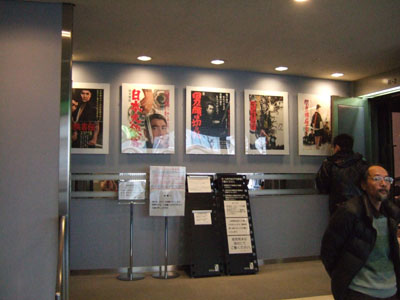
The last day of the symposium was devoted to two films that show how world film language changed between the mid-1910s and the early 1920s. Goro Masamune (1915) is a complicated tale about a swordsmith and the dramatic results of his mysterious parentage. It offered a stringent version of the sort of tableau staging we find in Europe and the US at the same period. As with those films, Goro Masamune used lateral staging and some striking depth effects, as well as long takes: I counted 58 shots and 24 intertitles across its 58 minutes.
With 356 shots and 25 intertitles, Roben-sugi exemplified a more cutting-based approach to cinematic storytelling. Scenes were broken down into many shots, often with a great variety of setups; the 180-degree system is in force; and many expressive effects were based on intercut close-ups. In the lengthy final scene, Roben, a temple bishop, discovers his long-lost mother and she prostrates herself before him. The action is played out in high-angle shots of the mother and low-angle shots of Roben. You couldn’t ask for better proof that filmmakers around the world were adopting the US continuity approach than this 1922 film.
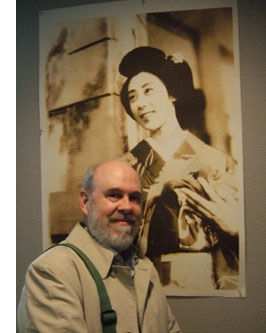 These two movies were powerful treats, and the day was embellished with a visit behind the scenes to the Film Center’s staff area, where I got Yuri to shoot me with one of my favorites, Yamada Isuzu.
These two movies were powerful treats, and the day was embellished with a visit behind the scenes to the Film Center’s staff area, where I got Yuri to shoot me with one of my favorites, Yamada Isuzu.
Earlier in the week, with Kyoko Hirano, I’d visited the Film Center to catch an item in its massive Makino Masahiro retrospective. Makino, son of Japan’s pioneering director Makino Shozo, directed films from the late 1920s to the early 1970s. For his centenary, the Center has mounted 100 programs of his work. No, that’s not a typo. The screenings include 110 titles directed or produced by Makino—and of course several others are lost. Japanese filmmakers are nothing if not prolific.
The film that Kyoko and I saw was Japanese Gangster Story 6: Sake Cup of the White Sword (1967), starring Takakura Ken. The plot consisted of intrigues crisscrossing rival gangs during the 1920s, capped by two bloody fights at the end. Ken doesn’t say much, but the camera loves him; early in the film he seemed to me to get the biggest close-ups. In the finale, of course he sacrifices himself for his gang boss. Is any genre cinema more standardized than the 1960s-1970s yakuza yarn? After a lunch of the Asakusa version of big Hiroshima-style omelettes, Makino’s buoyant retake on the classic tropes was a filling dessert.
The people
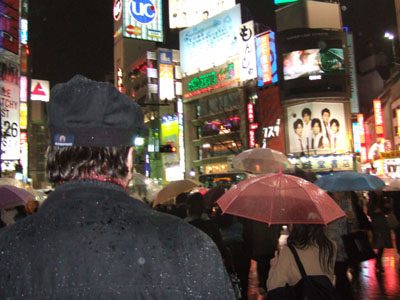
The third factor that has made this trip so pleasant has been the people. Hanging out with Yuri was great fun, and as luck would have it, Wisconsin film guy Michael Pogorzelski was visiting Tokyo at the same time. Mike is the archivist for the Academy of Motion Picture Arts and Sciences, and he restores classic films for the AMPAS collection. (It isn’t all Hollywood, either: the archive is handling Satayajit Ray and Stan Brakhage.) Darkness and rain turned our trip through Shibuya into a scene out of Blade Runner.
Then there was Komatsu Hiroshi, who invited me to the symposium. Hiroshi is one of Japan’s top film historians, a man tirelessly committed to finding Japanese films and explaining their significance. He has made his appearance on this blog before. There was also Fujiwara Toshi, an exuberant young filmmaker I first met in Kyoto about ten years ago. Toshi has directed docs about Amos Gitai and other filmmakers, and his latest fiction film, We Can’t Go Home Again, played at the Berlin festival.
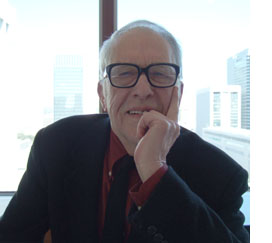 I’ve mentioned Kyoko Hirano, another former student and a best-selling author. Then there was my lunch with Donald Richie, hearty at 82 and planning more books, film screenings, and festival trips. His classic, The Inland Sea, is now being translated into Romanian. He gave me a copy of his newest, A Tractate on Japanese Aesthetics and I reciprocated with a copy of Poetics of Cinema. Donald’s book is as delicate and sharp as a Basho lyric; beside it, my book looks like an andiron.
I’ve mentioned Kyoko Hirano, another former student and a best-selling author. Then there was my lunch with Donald Richie, hearty at 82 and planning more books, film screenings, and festival trips. His classic, The Inland Sea, is now being translated into Romanian. He gave me a copy of his newest, A Tractate on Japanese Aesthetics and I reciprocated with a copy of Poetics of Cinema. Donald’s book is as delicate and sharp as a Basho lyric; beside it, my book looks like an andiron.
At the symposium I learned a great deal from Prof. Takemoto Mikio, director of the Tsubouchi Memorial Theatre Museum at Waseda University, and the vice-director Prof. Akiba Hirokazu; Prof. Takeda Kiyoshi, who studied with Christian Metz; Prof. Nagata Yasushi of Theatre Studies; and many others who contributed talks and comments.
Finally, one more person, the one who spurred me to study Japanese cinema.
Ozu Yasujiro‘s gravesite is in Kita-Kamakura, about an hour southwest of Tokyo by train. In the summer of 1988, Kristin and I were led there by Donald, and so I was due for another pilgrimage. The day was cool and sunny, perfect for a brisk walk through the grounds of Engaku-Ji Temple.
At the end of my trip was the gravestone, which famously bears a single character: Mu, or nothing. Twenty years ago, two beer cans sat reverently on the stone, but today there was an opened bottle of sake. A cigarette lighter was tucked into a hole in the surrounding stone fence. Ozu, fierce smoker and professional drinker, was in his element.
On the platform and then on the train, I let my eyes drift among the schoolkids and the teenyboppers and the salarimen and the grave elders with hygiene masks. I began to imagine how Ozu, the poet of the transience of city life and the comic poignancy of human ties, would turn us all into cinema. He might put the camera over there, squatting on the floor of the traincar. That boy with the backpack might give a sassy reply to his father. Those two stylish office ladies sharing an iPod while a middle-aged man snores beside them–surely that’s a setup for a gag. Playing with the possibilities, one gaijin felt a pang of rapture at the blending of life and art.

Minding movies
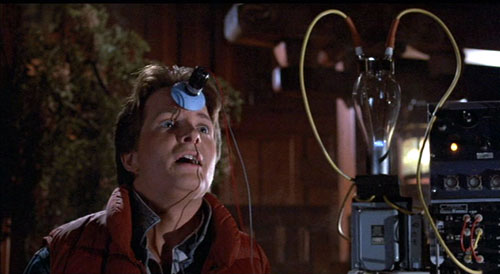
DB here:
When we watch films, our bodies and minds are engaged at a great many levels. Nobody doubts this claim. The interesting questions are: What forms does this engagement take? What gives movies the ability to seize our senses, prod our minds, and trigger emotions? How have filmmakers constructed films so as to tease us into such activities? What, to use a phrase from the philosopher Noël Carroll, creates the power of movies?
On this blogsite, I’ve touched on such questions in concrete cases—how eye movements shape our uptake of story information (here and here), how suspense can be created and sustained (here). Those are just small-scale samples of what is, to me, an exciting and promising way of studying certain aspects of cinema. That research trend is growing substantially, and an upcoming event on our home turf marks a new phase.
In June, the Society for Cognitive Studies of the Moving Image will hold a conference here in Madison. This organization was officially created in 2006. Its membership grew out of an informal group of scholars who had been meeting every couple of years since 1997. The meetings have been stimulating affairs, bringing together film historians and theorists, filmmakers, philosophers, and social scientists. Now we’re a full-fledged, incorporated association. We have annual membership dues (cheap at $25), a slate of officers, and a set of bylaws. The Society’s conferences will become annual next year, when we convene at the University of Copenhagen.
You can learn details about the organization here, and you can scan the conference schedule here. There’s also information about getting to Madison and visiting local attractions. (I recommend The House on the Rock.) The earlier incarnation of our group, The Center for Cognitive Studies of the Moving Image, has a rather full archive here.
As president of SCSMI, I’ve had my say about the organization’s remit on the webpage. I’m using today’s blog entry to gesticulate toward some ways that the organization tries to advance our understanding of films, filmmaking, and film viewing. I’ll also shamelessly promote our event.
What is this fascinating new film theory known as cognitivism?
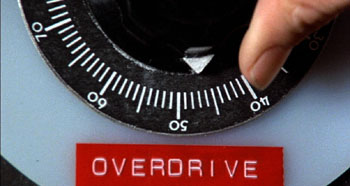
There are, roughly, two ways to think about doing film theory. One way is to look at a body of research or reflection in some established area (history, philosophy, psychology, etc.) and ask: What can it tell me about movies? So you might look at Freudian psychoanalysis or Gestalt perceptual psychology as a whole and then home in on ideas that seem to have relevance to cinema.
The other way to do film theory is to look closely at some filmic phenomenon and ask: What’s the best way to understand this aspect of movies? Your reading and thinking might then lead you to adjacent fields of inquiry for help. In the first instance, you start broad and move to particular cases. In the second, you start with particular cases and explore what broader ideas or information can shed light on them.
On the whole, academic film studies of the 1970s and 1980s started from the big-picture end. Several scholars decided, on various grounds, that psychoanalysis (a mixture of Freudian and Lacanian versions), provided a powerful explanatory system for virtually all human activity. The ideas of that system were then mapped onto many humanities disciplines, and then applied to particular instances of literature, the visual arts, and cinema. Many times, the big system became a doctrinal whole, a Theory of Everything, that was unquestioningly accepted.
In a 1989 essay called “A Case for Cognitivism” (available online here), I suggested that Freud did not intend his theories to become this sort of all-encompassing doctrine. And whatever Freud thought, in that essay and a later one for Post-Theory I argued that it’s more fruitful to develop film theories in a middle-level fashion, shifting from concrete problems to broader explanatory frameworks. My collaborator Noël Carroll called this focus on particular problems “piecemeal” theorizing.
It was through middle-level, piecemeal thinking that I first became interested in the cognitive sciences. During the early 1980s, I was concerned to understand how films told their stories. This process was usually called narration. From the start it seemed clear to me that filmic storytelling doesn’t work unless the spectator does certain things. We make assumptions, frame expectations, notice certain things, draw inferences, and pass judgments on what’s happening on the screen.
Film narratives are designed for just this sort of active pickup. I was interested, then, in how certain traditions of filmmaking shaped that pickup—by parceling out story information, composing shots, structuring scenes, and so on. Going beyond those particular traditions, what general capacities of spectators enabled us to understand the twists and turns of a film’s action, as presented by the movie?
During the 1960s Christian Metz had posed my question in a precise and provocative way—“We must understand how films are understood”—and had used it to found his initial version of a semiotics of cinema. But by the early 1980s, it wasn’t a question that much exercised people working in the dominant paradigm of the moment, psychoanalysis. Moreover, I was and remain skeptical of the psychoanalytic framework; I don’t think it has very solid scientific support.
So I began reading in other domains of psychology. At this point, the “cognitive sciences” were coming into their own as a result of work in linguistics, psychology, and anthropology. I didn’t have the benefit of Howard Gardner’s masterful state-of-play survey The Mind’s New Science (1985), but I saw some of the convergences he was pointing out. Perceptual psychology, social psychology, the shortcuts and shortcomings of informal reasoning, studies in classification and story comprehension–all these illuminated my central questions.
Characterizing, quick and dirty
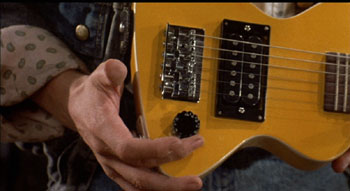
The answers I proposed to those questions showed up in Narration in the Fiction Film (1985). Nowadays we’d call it an attempt at reverse engineering. In many instances, that book argued, features of narratives in film seemed designed to solicit activities that research in the cognitive sciences has studied. Here’s one example.
The first time we encounter a character in a narrative, we tend to form an immediate, fairly fixed judgment about what sort of person she or he is. Why is this? Why don’t we suspend judgment and wait until we have more information? At least two reasons.
First is what psychologists call the primacy effect, the likelihood that the first item or few items in a series tend to form a benchmark for what will follow. Here are two multiplication exercises:
8 x 7 x 6 x 5 x 4 x 3 x 2 x 1 = ?
1 x 2 x 3 x 4 x 5 x 6 x 7 x 8 = ?
Give a person just one of the problems and ask him or her not to do the math but to quickly offer a rough estimate of the size of the result. What happens? People given the first problem tend to give bigger estimates than those given by people who see the second problem. Even though the product is exactly the same, the order of presentation—starting with large or small numbers—seems to have biased people toward different results. The initial items become a rangefinding device for later judgments.
A second reason for our snap judgments about characters stems from a well-supported finding of social psychology. We tend to size up other people using a rule of thumb, or heuristic, that attributes their actions to personality rather than to circumstances. If someone acts bossy in a meeting, we’re inclined to say that the person has an aggressive nature. But if you ask the person why he or she came on so strong, the answer is likely to be “I was having a bad day,” “The responses I was getting were just so lame,” “The pressures of those meetings are intolerable,” and so on. This is called the fundamental attribution error. We tend to assign behavior to character traits rather than take into account contextual factors. We are biased toward believing that others’ misbehavior is due to their temperament while ours was forced by circumstances beyond our control.
In real life, the primacy effect and the fundamental attribution error can be quite unfair ways of coming to conclusions, and they can lead us astray. But filmmakers and other storytellers, being intuitive psychologists like the rest of us, realize how strong these heuristics are, so they design their stories so as to make use of them. Usually, when a character walks into the story world, he or she is characterized by signaling key traits right off the bat.
Consider Back to the Future (released the same year as NiFF was published). It might have begun with Marty McFly skating down the street for several minutes on the way to Doc’s laboratory. Instead, the narration introduces Marty by showing him cranking up the lab’s amplifier to overdrive. He strikes a star pose, hits a guitar chord, and is blasted off his feet. He’s shaken up but awestruck: “Whoa. . . Rock and roll.” We now assume that Marty likes to take risks, that he’s committed to his music, that he’s a bit preening, and that he can bounce back. Likewise, before Marty comes in, during the opening shots exploring the lab, we get information about Doc as well, though more indirectly. For both characters, the narration encourages us to leap to conclusions that will be confirmed again and again in the story that follows.
Sometimes, though, filmmakers thwart our propensities by either neutralizing the initial cues (we don’t know how to read the character) or offering strong ones that are later countermanded (we’ve been led to misread the character). Preminger offers wonderful examples of both possibilities in Anatomy of a Murder. Either way, the filmmaker is still exploiting the primacy effect and the fundamental attribution error, but in order to yield different experiences. Meir Sternberg’s superb book, Expositional Modes and Temporal Ordering in Fiction (1978), points out such strategies and explores in detail what he called, “the rhetoric of anticipatory caution”—the ways that novelists trigger the primacy effect only to force us to reevaluate our snap judgments. Sternberg was, I think, one of the first narrative theorists to bring cognitive research to bear on storytelling strategies.
I found, in short, that experimental results in the cognitive sciences could explain, in a fairly direct way, many of the tactics that stories use to engage us. Contrary to what my Wikipedia entry implies, I’m not a cognitivist 24 hours a day; many of the research questions I tackle don’t depend on such assumptions. Still, since NiFF, I’ve revisited them a few times. Making Meaning (1988), for example, tried to show that a lot of cinematic interpretation is explainable in cognitive terms.
Most recently, some essays in Poetics of Cinema (2007) draw on psychological and anthropological research to clarify why films use certain formal strategies. For instance, what aspects of Mildred Pierce mislead us about what is happening, and how are we led to misremember those aspects? Why do actors stare at each other in a way we seldom see in life? And why don’t they blink the way we do? Another essay in the collection, “Convention, Construction, and Cinematic Vision,” moves to broader terrain. It argues that a great deal of our understanding of films relies not on codes particular to cinema (contra the semiotic tradition) but rather on our everyday inference-making habits and skills.
The cognitive turn
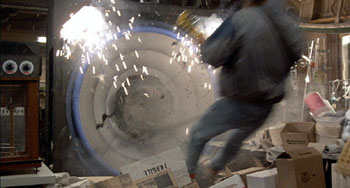
Written in 1982-83, Narration in the Fiction Film leaned heavily on what was then called “New Look” psychology, the first wave of cognitive research in psychology. The pioneers of that program, such as Jerome Bruner, R. L. Gregory, Ulrich Neisser, and others, emphasized the mind’s role in actively building up structures of meaning on the basis of incomplete or ambiguous information. So my claims that films cue us to flesh out their action, invoke schemas (knowledge structures), ask us to reorganize story order, and to fill in missing bits—all stem from that research program. The art historian E. H. Gombrich, another big influence on me, was perhaps the first person to see how New Look psychology could inform theorizing in the humanities.
In the late 1990s, cognitively inflected film theory really took off, and in directions that shaped the growth of SCSMI. The first avatar of the SCSMI was founded by Joseph and Barbara Anderson. Joe and I were graduate students together at Iowa in the early 1970s, where he wrote a dissertation on binocularity in the cinema, and later we worked together here at Madison, where Barb was a grad student. Joe taught a course in film perception that I sat in on occasionally, and it was a revelation. When NiFF came out, Joe (by then a film producer) felt encouraged to go on with his own work, and the result was The Reality of Illusion (1998). It proposed an alternative to the New Look orientation, grounded in J. J. Gibson’s theories of ecological perception. Since then, Joe and Barb have published two anthologies, with contributions from SCSMI members.
At the same period, Torben Grodal published Moving Pictures (1997) a comprehensive theory of cinema grounded in the cognitive sciences, with particular focus on brain functions. Torben was also a founding member of the SCSMI group.
Since 2000, publications in the area have increased markedly, parallel to the growth of cognitive studies in literature and other areas. I hope to discuss some of these books and articles in a later blog.
Broadly, cognitive film theory has tracked the development of the cognitive sciences. After the New Look and ecological frameworks, we’re seeing more emphasis on evolutionary psychology and neuroscience as explanatory forces. Film scholars who talk about adaptive fitness and mirror neurons are still, for the most part, doing middle-level, piecemeal theorizing—trying to explain particular processes by appeal to what scientific research has brought to light. None, I think, expects cognitivism to provide a Big Theory of Everything.
Early on, Noël, I, and others sought to show that the cognitive perspective offered better explanations for some aspects of cinema than the dominant psychoanalytic approach. We were sometimes chastised for being pugilistic and polemical. Yet interestingly, nobody responded to our arguments, let alone replied at the same level of detail. The situation reminded me of Godard’s response to people who complained that Letter to Jane (1972) mistreated Jane Fonda. His reply was: “I merely wrote her a letter, but she never answered.”
In the years since, I have yet to see a substantive critique of the cognitive research tradition in film studies. The only extended argument I know of isn’t really focused on cognitivism and is surprisingly flimsy. (My response to it is here.)
Advocates for Poststructuralist or Cultural Studies perspectives sometimes dismiss the cognitive framework as “common sense.” But common sense is in the eye of the beholder, and there’s no reason to assume that flagrantly uncommensical claims are any more likely to be accurate than those which seem intuitively right. In doing research, we just try to ascertain the evidence for any belief, commonsensical or not. The primacy effect might seem simply to rely on the old saw, “First impressions matter,” but it’s good to know that at least one commonplace is well supported. By contrast, the fundamental attribution error doesn’t on the face of it seem either common sense or not. It’s something that our folk psychology doesn’t guide us toward or away from. It’s actually a fresh discovery about some habits of our minds.
Moreover, a great deal of cognitivism flouts what some might take as common sense. Before Chomsky, most intellectuals thought that language was social through and through. He was able to show that certain features of it, including syntax, are likely to be part of our biological endowment. A lot of cognitive social psychology has been dedicated to showing how common-sense inferences are often illogical. These findings are now being popularized in books like Cordelia Fine’s A Mind of Its Own: How Your Brain Distorts and Deceives, and Thomas Kida’s Don’t Believe Everything You Think (from which my multiplication example comes). As for humanists’ suspicion of science, I address that unfounded fear in the introduction to Poetics of Cinema. If you prefer big-picture arguments about the issue, try Edward Slingerland’s new book.
Movies on the brain
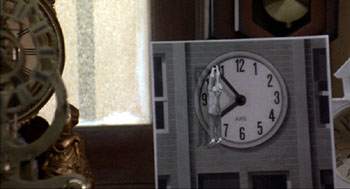
The real debate on cognitivism in film studies has yet to take place. Meanwhile, the cognitivists keep plugging away. Over the years, the Society for Cognitive Studies of the Moving Image has attracted, broadly, three sorts of persons. All are represented in our upcoming conference.
*There are the film-trained academics like me, who have branched out into cognitive film theory to illuminate particular research projects. Our June gathering includes a great many such scholars, many of them pioneers in the cognitive perspective like the Andersons, Carroll, Grodal, Murray Smith, Carl Plantinga, Patrick Colm Hogan, et al.
*There are the psychologists, who are interested in explaining the psychological mechanisms of cinema. They tend to focus on particular phenomena, like eye movements, cutting, or other triggering processes, and they study the effects at various levels, from perceptual response to brain-scanning. Their great predecessor is Julian Hochberg, who studied cinema as a sort of stage show that displayed psychological processes with particular clarity. A magisterial collection of Hochberg’s work, In the Mind’s Eye, has recently been published. At our June gathering, an entire thread is largely devoted to psychological research into cinematic uptake. Our two plenary speakers, Uri Hasson of NYU and Dan Levin of Vanderbilt, also represent this tradition.
*Then there are the philosophers. Most are concerned with art and literature, and most incline to an Anglo-American form of conceptual analysis. These scholars come to SCSMI because they are of a cognitivist bent, or because they want to argue with cognitivist work, or because this is a useful forum for the sort of film-based questions they want to pursue. The June event includes many of the most prominent philosophers of film, and a panel session is devoted to critiques of Noël Carroll’s recent book The Philosophy of Motion Pictures.
Visit our schedule page, and you’ll get a sense of how varied this work is. Speakers are talking about everything from editing patterns to the effects of digital technology on filmic perception. The participants consider propaganda, melodrama, TV series, and videogames. There are presentations on the emotional dimensions of horror and on the ways that color works in particular movies. How do viewers who have never seen films before understand cutting? In what sense is film content fictional? How does the language of film theory affect the way we theorize? Is there something inherently filmic that sets cinema apart from other media?
Cognitivism isn’t a Big Theory of Everything; nobody has a clue about how these diverse research programs would fit together. The variety is what makes it fun. I think that anybody who wants to know more about movies would find something worthwhile at the Madison event, not least the opportunity to shmooz. And there’s The House on the Rock.
The evidence is mounting. Cognitivism is cool.
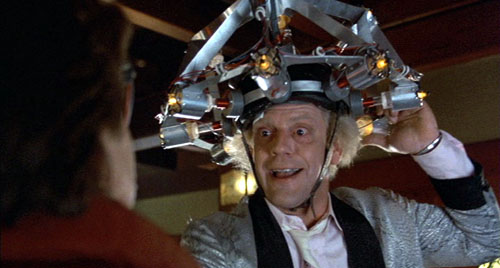
PS 17 April: This line of thought strikes a chord in Lee Marshall, who offers encouragement at Screen International here.













